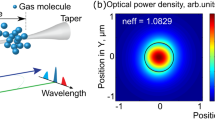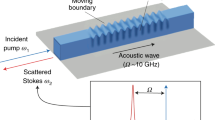Abstract
Brillouin scattering has applications ranging from signal processing1,2, sensing3 and microscopy4 to quantum information5 and fundamental science6,7. Most of these applications rely on the electrostrictive interaction between light and phonons3,7,8. Here we show that in liquids optically induced surface deformations can provide an alternative and far stronger interaction. This allows the demonstration of ultralow-threshold Brillouin lasing and strong phonon-mediated optical coupling. This form of strong coupling is a key capability for Brillouin-reconfigurable optical switches and circuits9,10, for photonic quantum interfaces11 and to generate synthetic electromagnetic fields12,13. While applicable to liquids quite generally, our demonstration uses superfluid helium. Configured as a Brillouin gyroscope14 this provides the prospect of measuring superfluid circulation with unprecedented precision, and exploring the rich physics of quantum fluid dynamics, from quantized vorticity to quantum turbulence15,16.
This is a preview of subscription content, access via your institution
Access options
Access Nature and 54 other Nature Portfolio journals
Get Nature+, our best-value online-access subscription
$29.99 / 30 days
cancel any time
Subscribe to this journal
Receive 12 print issues and online access
$209.00 per year
only $17.42 per issue
Buy this article
- Purchase on Springer Link
- Instant access to full article PDF
Prices may be subject to local taxes which are calculated during checkout




Similar content being viewed by others
Code availability
All relevant codes or algorithms are available from the corresponding author on reasonable request.
References
Kittlaus, E. A., Otterstrom, N. T. & Rakich, P. T. On-chip inter-modal Brillouin scattering. Nat. Commun. 8, 15819 (2017).
Li, J., Lee, H. & Vahala, K. J. Microwave synthesizer using an on-chip Brillouin oscillator. Nat. Commun. 4, 2097 (2013).
Eggleton, B. J., Poulton, C. G. & Pant, R. Inducing and harnessing stimulated Brillouin scattering in photonic integrated circuits. Adv. Opt. Photon. 5, 536–587 (2013).
Scarcelli, G. & Yun, S. H. Confocal Brillouin microscopy for three-dimensional mechanical imaging. Nat. Photon. 2, 39–43 (2008).
Renninger, W. H., Kharel, P., Behunin, R. O. & Rakich, P. T. Bulk crystalline optomechanics. Nat. Phys. 14, 601–607 (2018).
Kharel, P. et al. High-frequency cavity optomechanics using bulk acoustic phonons. Sci. Adv. 5, eaav0582 (2019).
Kashkanova, A. D. et al. Superfluid Brillouin optomechanics. Nat. Phys. 13, 74–79 (2017).
Giorgini, A. et al. Stimulated Brillouin cavity optomechanics in liquid droplets. Phys. Rev. Lett. 120, 073902 (2018).
Ruesink, F., Mathew, J. P., Miri, M.-A., Alù, A. & Verhagen, E. Optical circulation in a multimode optomechanical resonator. Nat. Commun. 9, 1798 (2018).
Shen, Z. et al. Reconfigurable optomechanical circulator and directional amplifier. Nat. Commun. 9, 1797 (2018).
Safavi-Naeini, A. H. & Painter, O. Proposal for an optomechanical traveling wave phonon–photon translator. New J. Phys. 13, 013017 (2011).
Fang, K. et al. Generalized non-reciprocity in an optomechanical circuit via synthetic magnetism and reservoir engineering. Nat. Phys. 13, 465–471 (2017).
Schmidt, M., Kessler, S., Peano, V., Painter, O. & Marquardt, F. Optomechanical creation of magnetic fields for photons on a lattice. Optica 2, 635–641 (2015).
Li, J., Suh, M. & Vahala, K. Microresonator Brillouin gyroscope. Optica 4, 346–348 (2017).
Sachkou, Y. P. et al. Coherent vortex dynamics in a strongly interacting superfluid on a silicon chip. Science 366, 1480–1485 (2019).
Gauthier, G. et al. Giant vortex clusters in a two-dimensional quantum fluid. Science 364, 1264–1267 (2019).
Reinke, C., Rakich, P. T., Wang, Z., Camacho, R. & Davids, P. Giant enhancement of stimulated Brillouin scattering in the subwavelength limit. Phys. Rev. X 2, 011008 (2012).
Kittlaus, E. A., Shin, H. & Rakich, P. T. Large Brillouin amplification in silicon. Nat. Photon. 10, 463–467 (2016).
Florez, O. et al. Brillouin scattering self-cancellation. Nat. Commun. 7, 11759 (2016).
Van Laer, R., Kuyken, B., Van Thourhout, D. & Baets, R. Interaction between light and highly confined hypersound in a silicon photonic nanowire. Nat. Photon. 9, 199–203 (2015).
Shin, H. et al. Tailorable stimulated Brillouin scattering in nanoscale silicon waveguides. Nat. Commun. 4, 1944 (2013).
Enzian, G. et al. Observation of Brillouin optomechanical strong coupling with an 11 GHz mechanical mode. Optica 6, 7–14 (2019).
Gundavarapu, S. et al. Sub-hertz fundamental linewidth photonic integrated Brillouin laser. Nat. Photon. 13, 60–67 (2019).
Dong, C. H. et al. Brillouin-scattering-induced transparency and non-reciprocal light storage. Nat. Commun. 6, 6193 (2015).
Wolff, C., Steel, M. J., Eggleton, B. J. & Poulton, C. G. Stimulated Brillouin scattering in integrated photonic waveguides: forces, scattering mechanisms, and coupled-mode analysis. Phys. Rev. A 92, 013836 (2015).
Kaminski, S., Martin, L. L., Maayani, S. & Carmon, T. Ripplon laser through stimulated emission mediated by water waves. Nat. Photon. 10, 758–761 (2016).
Harris, G. I. et al. Laser cooling and control of excitations in superfluid helium. Nat. Phys. 12, 788–793 (2016).
Baker, C. G. et al. Theoretical framework for thin film superfluid optomechanics: towards the quantum regime. New J. Phys. 18, 123025 (2016).
Bahl, G., Tomes, M., Marquardt, F. & Carmon, T. Observation of spontaneous Brillouin cooling. Nat. Phys. 8, 203–207 (2012).
Bahl, G. et al. Brillouin cavity optomechanics with microfluidic devices. Nat. Commun. 4, 2994 (2013).
McAuslan, D. L. et al. Microphotonic forces from superfluid flow. Phys. Rev. X 6, 021012 (2016).
Atkins, K. R. Third and fourth sound in liquid helium II. Phys. Rev. 113, 962–965 (1959).
Ashkin, A., Dziedzic, J. M., Bjorkholm, J. E. & Chu, S. Observation of a single-beam gradient force optical trap for dielectric particles. Opt. Lett. 11, 288–290 (1986).
Wiederhecker, G. S., Dainese, P. & MayerAlegre, T. P. Brillouin optomechanics in nanophotonic structures. APL Photon. 4, 071101 (2019).
Rakich, P. & Marquardt, F. Quantum theory of continuum optomechanics. New J. Phys. 20, 045005 (2018).
Van Laer, R., Baets, R. & Van Thourhout, D. Unifying Brillouin scattering and cavity optomechanics. Phys. Rev. A 93, 053828 (2016).
Metzger, C. H. & Karrai, K. Cavity cooling of a microlever. Nature 432, 1002–1005 (2004).
Jourdan, G., Comin, F. & Chevrier, J. Mechanical mode dependence of bolometric backaction in an atomic force microscopy microlever. Phys. Rev. Lett. 101, 133904 (2008).
Verhagen, E., Deleglise, S., Weis, S., Schliesser, A. & Kippenberg, T. J. Quantum-coherent coupling of a mechanical oscillator to an optical cavity mode. Nature 482, 63–67 (2012).
Zhu, J. et al. On-chip single nanoparticle detection and sizing by mode splitting in an ultrahigh- Q microresonator. Nat. Photon. 4, 46–49 (2010).
Grudinin, I. S., Matsko, A. B. & Maleki, L. Brillouin lasing with a CaF2 whispering gallery mode resonator. Phys. Rev. Lett. 102, 043902 (2009).
Lee, H. et al. Chemically etched ultrahigh- Q wedge-resonator on a silicon chip. Nat. Photon. 6, 369–373 (2012).
Guo, C. et al. Ultralow-threshold cascaded Brillouin microlaser for tunable microwave generation. Opt. Lett. 40, 4971–4974 (2015).
Feng, X. L., White, C. J., Hajimiri, A. & Roukes, M. L. A self-sustaining ultrahigh-frequency nanoelectromechanical oscillator. Nat. Nanotechnol. 3, 342–346 (2008).
Destgeer, G. & Sung, H. J. Recent advances in microfluidic actuation and micro-object manipulation via surface acoustic waves. Lab Chip 15, 2722–2738 (2015).
Palombo, F. & Fioretto, D. Brillouin light scattering: applications in biomedical sciences. Chem. Rev. 119, 7833–7847 (2019).
Acknowledgements
This work was funded by the US Army Research Office through grant number W911NF17-1-0310 and the Australian Research Council Centre of Excellence for Engineered Quantum Systems (EQUS, project number CE170100009). W.P.B. and C.G.B respectively acknowledge Australian Research Council Fellowships FT140100650 and DE190100318. This work was performed in part at the Queensland node of the Australian National Fabrication Facility, a company established under the National Collaborative Research Infrastructure Strategy to provide nano- and microfabrication facilities for Australia’s researchers.
Author information
Authors and Affiliations
Contributions
X.H., G.I.H., C.G.B., A.S. and Y.L.S. collected the data. X.H., G.I.H., C.G.B., A.S., Y.L.S. and W.P.B. performed the data analysis and developed the theory. X.H., G.I.H., C.G.B., A.S., Y.L.S., Y.P.S. and S.F. contributed to device fabrication and building the experimental set-up. C.G.B. and W.P.B. conceived the idea. All authors contributed to the manuscript. W.P.B. led the project with assistance from C.G.B. and G.I.H.
Corresponding author
Ethics declarations
Competing interests
The authors declare no competing interests.
Additional information
Peer review information Nature Physics thanks Tal Carmon and Gustavo Wiederhecker for their contribution to the peer review of this work.
Publisher’s note Springer Nature remains neutral with regard to jurisdictional claims in published maps and institutional affiliations.
Supplementary information
Supplementary Information
Supplementary information: 26 pages; 13 figures.
Source data
Source Data Fig. 3
Source data for the plots of Fig. 3 in the main text.
Source Data Fig. 4
Source data for the plots of Fig. 4 in the main text.
Rights and permissions
About this article
Cite this article
He, X., Harris, G.I., Baker, C.G. et al. Strong optical coupling through superfluid Brillouin lasing. Nat. Phys. 16, 417–421 (2020). https://doi.org/10.1038/s41567-020-0785-0
Received:
Accepted:
Published:
Issue Date:
DOI: https://doi.org/10.1038/s41567-020-0785-0
This article is cited by
-
Dissipative optomechanics in high-frequency nanomechanical resonators
Nature Communications (2023)
-
Optomechanics for quantum technologies
Nature Physics (2022)
-
Extreme quantum nonlinearity in superfluid thin-film surface waves
npj Quantum Information (2021)



